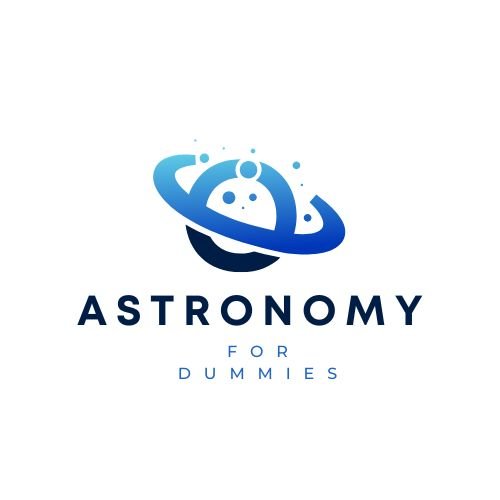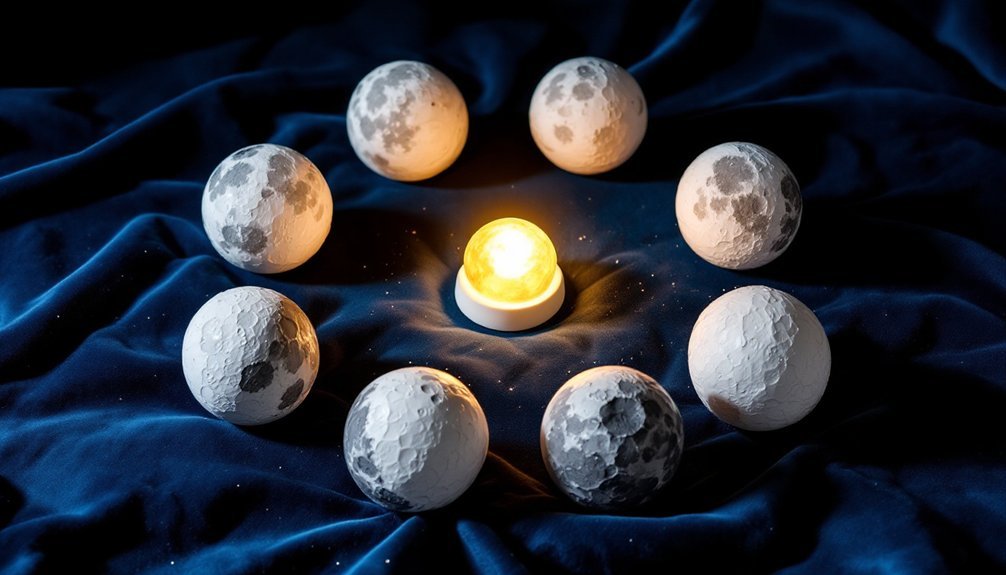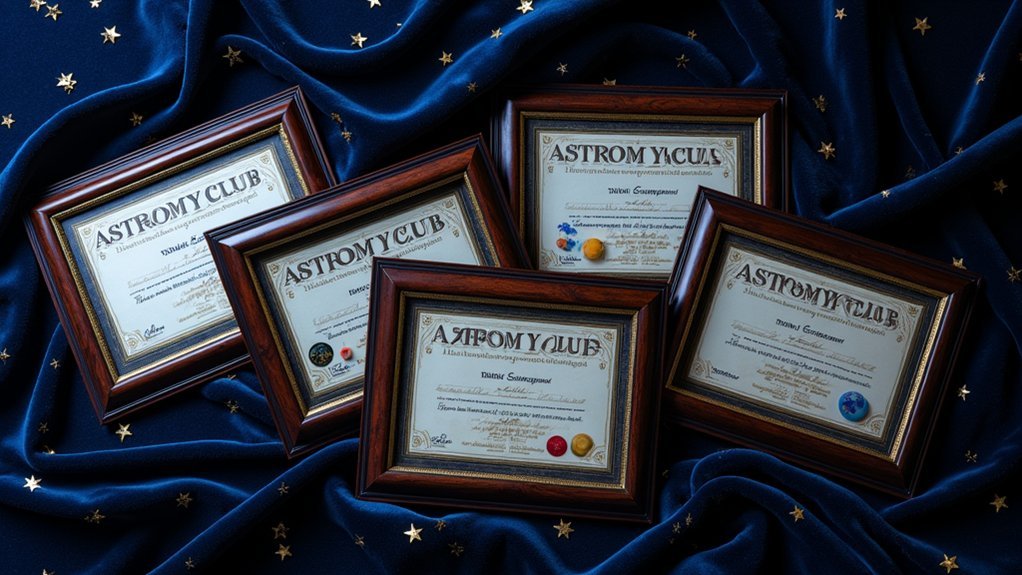You've probably noticed your child's eyes light up when they spot the moon in the night sky. It's a natural gateway to spark their interest in astronomy, but finding the right teaching tools can be challenging. From interactive illuminated models to hands-on building kits, today's moon phase learning tools offer more than just basic education—they create memorable experiences. Let's explore seven proven models that'll transform your young astronomer's cosmic curiosity into genuine understanding.
Uncle Milton Moon in My Room – Remote Control Light-Up Lunar Phases
The Uncle Milton Moon in My Room brings celestial learning right into a child's bedroom, making it an ideal choice for young astronomy enthusiasts ages 6-15.
You'll find this lightweight, 10-inch model easy to mount on walls or ceilings. The remote control lets you explore 12 distinct lunar phases, while an automatic mode cycles through them. There's also a convenient 30-minute auto-shutoff feature that preserves battery life when used as a nightlight.
The included STEM learning poster helps kids connect real-world astronomy with the device's realistic moon texture. While the full moon setting might be too bright for some, the unit's 4.6-star rating from nearly 3,000 users confirms its effectiveness as both an educational tool and room decoration.
Best For: Young astronomy enthusiasts and children ages 6-15 who want an interactive, educational night light that teaches about lunar phases while adding a decorative touch to their bedroom.
Pros:
- Educational STEM value with realistic moon phases and included learning materials about lunar cycles
- Versatile functionality with both remote control and automatic modes, plus auto-shutoff feature
- Easy installation and lightweight design makes it simple to mount anywhere in the room
Cons:
- Full moon setting may be too bright for comfortable sleeping
- Battery compartment requires a screwdriver to access and needs regular battery changes
- Remote control requires direct line of sight to function properly
Sun Earth Moon Orbital Model with Light (Educational Solar System Kit)
Designed for young astronomy enthusiasts, this illuminated orbital model serves as an engaging introduction to Earth's rotation, seasonal changes, and lunar phases. You'll find it useful for demonstrating basic astronomical concepts, including Earth's 23.5-degree tilt and its effect on seasons.
While the model's colorful design and cultural elements like Chinese seasonal labels add educational value, you'll need patience during assembly. The kit often comes with unclear instructions, and you might struggle with aligning components properly. Despite its mechanical limitations, it's still an effective tool for teaching children about eclipses and moon phases, though it's not meant for precise scientific applications.
Best For: Elementary and middle school students interested in astronomy who need a hands-on visual aid to understand basic celestial mechanics and seasonal changes.
Pros:
- Effectively demonstrates Earth's rotation, moon phases, and seasonal changes through an interactive, illuminated model
- Includes cultural elements like Chinese seasonal labels that add educational depth
- Colorful and engaging design that helps maintain children's interest while learning
Cons:
- Poor or missing assembly instructions make setup challenging
- Components can be difficult to align properly and some parts may be missing
- Not suitable for precise scientific demonstrations due to mechanical limitations
Moon Phase Flash Cards for Toddlers (9 Cards)
Perfect for children aged three and up, these vibrant moon phase flash cards combine educational value with engaging playability. Each card in the nine-card set features detailed moon illustrations on one side and extensive descriptions on the other, all secured with a convenient binder ring.
You'll appreciate the cards' practical 4.72 x 3.54-inch size that's ideal for small hands and easy storage. Whether you're teaching at home, in daycare, or a classroom setting, these flash cards help kids grasp lunar concepts through visual learning. They're particularly effective for preschool and kindergarten activities, making astronomy education both fun and memorable.
Best For: Parents, teachers, and caregivers looking to introduce children ages 3+ to lunar concepts through engaging visual learning cards.
Pros:
- Durable ring binding keeps cards organized and prevents loss
- Double-sided design with both illustrations and detailed descriptions
- Compact, child-friendly size perfect for small hands and easy storage
Cons:
- Limited to just 9 cards in the set
- Paper material may not withstand rough handling by young children
- Minimum age requirement of 36 months excludes younger toddlers
NewPath Phases of The Moon 3D Model Making Kit (24-7821)
Students enthusiastic to explore lunar science will find the NewPath Phases of The Moon 3D Model Making Kit an ideal hands-on learning tool. This individual student edition lets you assemble detailed representations of the Moon, Earth, and Sun to understand lunar phases.
You'll discover how the Moon transforms from new moon to waxing crescent, first quarter, waxing gibbous, full moon, waning gibbous, third quarter, and waning crescent. The kit aligns with Next Generation Science Standards and works perfectly at home or in classrooms. Whether you're working solo or with a partner, you'll engage in a thorough learning process that helps you explore, explain, and evaluate your understanding of lunar mechanics.
Best For: Elementary and middle school students interested in astronomy who learn best through hands-on model building and visual demonstrations.
Pros:
- Provides a tangible, interactive way to understand lunar phases through physical model assembly
- Flexible for both individual and partner learning scenarios
- Aligns with educational standards while making complex astronomical concepts more accessible
Cons:
- Limited to one or two students per kit, making it potentially costly for larger classrooms
- Assembly required before learning can begin, which takes up educational time
- Physical model may have durability concerns with repeated use
Solar System and Moon Phase Flashcards for Toddlers & Kids
These vibrant flashcards offer parents and educators an engaging way to teach young learners about space, starting from age 3 and up. The set includes 24 double-sided cards featuring 15 solar system concepts and 9 moon phases, each measuring 4.72 x 3.54 inches.
You'll find colorful images paired with names on one side and descriptions on the other, making learning interactive and fun. The cards come organized with binder rings, so you can easily sort and display them in your classroom or learning space. With a 4.4-star rating from 273 reviews, these SANTSUN flashcards prove effective for homeschooling, daycare, and classroom use.
Best For: Parents, teachers, and caregivers looking to introduce children ages 3 and up to basic astronomy concepts through visual learning tools.
Pros:
- Double-sided design with images and descriptions provides comprehensive learning experience
- Durable cards with binder rings for easy organization and display
- Highly rated educational tool with positive teacher recommendations
Cons:
- Limited to 24 cards which may not cover all astronomical concepts
- Paper material may not withstand rough handling by younger children
- Relatively high price point given its position in bestseller rankings (#82,121)
Phases of the Moon Kit with 3-D Glow-in-the-Dark Moons & Stars
Hands-on learners will love exploring lunar science with the Great Explorations Phases of the Moon Kit, featuring eight detailed 3D moon models that glow in the dark. The kit includes 67 adhesive stars and an extensive guidebook packed with lunar facts and legends.
You'll appreciate how each model accurately represents different moon phases, making it easy to understand the waxing and waning cycle. The special glow-in-the-dark material creates a fascinating nighttime display, perfect for bedrooms or classrooms. While the mounting adhesive can be tricky, you'll get the best results by arranging the phases sequentially. This STEM-focused kit transforms moon phase education into an engaging, tactile experience.
Best For: Elementary and middle school students interested in astronomy, as well as educators teaching lunar phases through hands-on learning methods.
Pros:
- Detailed 3D moon models provide an accurate, tactile representation of lunar phases
- Glow-in-the-dark feature makes learning engaging and creates an attractive display
- Comprehensive guidebook includes educational content about moon facts and legends
Cons:
- Mounting adhesive can be difficult to work with effectively
- Higher price point compared to basic moon phase learning tools
- Limited to 8 phases, which may not show all subtle changes in lunar cycle
English Solar System Planetarium Model Educational Kit
Budding astronomers aged 8 and up will find the English Solar System Planetarium Model Educational Kit an engaging way to explore celestial mechanics. This DIY model helps you understand how the sun, Earth, and moon interact to create day, night, seasons, and eclipses.
The kit includes a seasonal plate that displays the four seasons and traditional Chinese solar terms. While assembly can be tricky with its gears and screws, once properly set up, you'll have a hands-on tool for exploring planetary movements. At 43 x 20 x 28 cm, it's compact enough for desktop demonstrations but substantial enough to show detailed orbital patterns.
Best For: Students and teachers ages 8+ who want a hands-on educational tool to understand basic celestial mechanics and seasonal changes through a physical model.
Pros:
- Effectively demonstrates multiple astronomical concepts including seasons, eclipses, and moon phases
- Includes detailed seasonal plate with both Western seasons and traditional Chinese solar terms
- Compact size makes it suitable for classroom demonstrations and home use
Cons:
- Assembly can be challenging with unclear instructions and potential fitting issues
- Some users report problems with screws and component alignment
- Quality of materials and construction could be improved for better durability
Factors to Consider When Choosing Moon Phase Learning Models for Kids
When you're selecting a moon phase learning model for your child, you'll need to evaluate several key elements to guarantee the best educational experience. Consider how the model's age-appropriate features and assembly requirements match your child's capabilities, while also examining the educational content's depth and accuracy. Make certain to assess the model's durability, material quality, and required storage space to ensure it fits both your home environment and long-term learning goals.
Age-Appropriate Learning Features
Selecting the right moon phase learning model requires careful consideration of age-appropriate features that match your child's developmental stage.
For toddlers, you'll want to focus on models with bright colors and simple visuals that introduce basic moon phase recognition. Preschoolers and kindergartners benefit from interactive elements like flashcards and hands-on models that make learning playful and engaging.
If you're shopping for children ages 6-15, look for models that explore more complex concepts like lunar cycles and eclipses. These advanced tools should include detailed scientific explanations and STEM content while remaining easy to assemble and use independently.
Remember that your child's learning style matters – choose models with clear instructions and age-appropriate complexity to guarantee they'll stay engaged and retain the information effectively.
Assembly and Setup Requirements
Three key assembly factors deserve careful attention when choosing a moon phase learning model for your child. First, check if the model comes with clear, detailed instructions that include visual guides, as this will greatly impact your setup experience. Second, confirm all components are included in the package before you begin assembly – you'll want to avoid the frustration of discovering missing parts midway through construction.
Consider whether you'll be helping your child with assembly or if they'll work independently. Some models are designed for solo assembly, while others work better with adult assistance. Look for kits that match your child's ability level and your intended involvement. Models with thorough assembly guides typically offer the smoothest setup experience and help maintain your child's interest throughout the learning process.
Educational Value and Content
The educational value of moon phase learning models hinges on their ability to transform complex astronomical concepts into digestible lessons for young minds. When choosing a model, you'll want to look for hands-on features that let your child actively participate in the learning process, as this greatly improves their understanding and retention of lunar concepts.
Make certain the model comes with supplementary materials like STEM posters or guidebooks that provide deeper context about lunar cycles. The best educational tools use bright, clear illustrations that help your child easily recognize different moon phases. Additionally, check if the model aligns with NGSS standards to guarantee it's delivering accurate scientific information. This way, you're investing in a tool that not only entertains but also properly educates your child about lunar astronomy.
Space and Storage Needs
Beyond educational features, practical space factors play a key role in choosing the right moon phase model for your child. You'll want to measure your intended display area first and check the model's dimensions to verify a comfortable fit in your child's bedroom or study space.
Look for models with smart storage solutions, like those with binder rings or built-in compartments, which help keep pieces organized and easily accessible. If you're planning to move the model between home and school, opt for lightweight versions that won't be cumbersome to transport. Also, check whether the model can be disassembled when not in use, especially for larger kits with multiple components. Don't forget to take into account the storage environment – some materials need protection from moisture or temperature extremes to stay in good condition.
Durability and Materials Quality
Durability stands as an essential factor when selecting moon phase learning models for kids' educational use. You'll want to look for products made from high-quality materials like durable plastics or sturdy paper that can withstand constant handling and enthusiastic exploration.
Pay attention to models featuring glow-in-the-dark elements that maintain their luminescence after light exposure, as these often indicate superior material quality. Check for secure assembly methods, particularly those using screws and metal connections rather than simple adhesives. You'll find that well-constructed models typically last longer in both classroom and home environments.
Before making your purchase, don't forget to read user reviews focusing on durability. These firsthand accounts will give you valuable insights into how the model holds up during regular use and whether it's worth your investment.
Frequently Asked Questions
How Long Do Glow-In-The-Dark Moon Models Typically Maintain Their Luminescent Properties?
You'll find most glow-in-the-dark moon models shine brightly for 15-30 minutes after exposure to light, though they'll remain dimly visible for several hours. They'll need recharging through light exposure for continued luminescence.
What Age Is Too Old to Start Learning About Moon Phases?
You're never too old to learn about moon phases! Whether you're 8 or 80, you can always expand your knowledge of lunar cycles. It's a fascinating topic that's accessible to all age groups.
Can Moon Phase Learning Models Help Children With Learning Disabilities?
You'll find moon phase models can greatly benefit children with learning disabilities. They provide hands-on, visual, and tactile learning experiences that help process information differently, making complex concepts more accessible and understandable.
Are Battery-Operated Moon Models Safe for Unsupervised Nighttime Use?
You shouldn't leave battery-operated moon models running unsupervised at night. They can overheat, pose fire risks, or leak batteries. For nighttime use, consider LED models with auto-shutoff features instead.
How Accurate Are These Educational Models Compared to Actual Astronomical Observations?
You'll find most quality educational moon phase models are 85-90% accurate in depicting lunar positions and cycles. They're simplified for learning but still match real astronomical patterns you'd observe in the night sky.
In Summary
When you're ready to help your child explore lunar phases, you'll find these seven models offer engaging ways to learn. From remote-controlled moons to hands-on craft kits, there's something for every age and learning style. Consider your child's interests and choose a model that matches their development level. You'll soon watch them transform into mini astronomers, enthusiastic to understand the moon's mysterious dance.





Leave a Reply